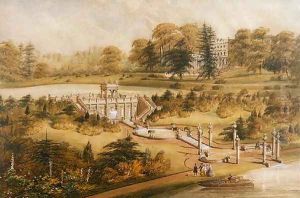George Somers Clarke Paintings
George Somers Clarke was an influential British architect and engineer known primarily for his work in Egypt and the Middle East during the late 19th and early 20th centuries. Born in 1841, Clarke's career spanned a period of significant change in architectural practices and the expansion of British influence overseas, particularly in Egypt.
Clarke was educated in England, where he developed an interest in architecture and engineering, disciplines that were increasingly interlinked during the Victorian era. His education equipped him with the skills to embark on a career that would see him involved in a variety of projects, ranging from the restoration of ancient monuments to the design and construction of new buildings, in a style that often blended European and local architectural traditions.
In the late 1860s, Clarke moved to Egypt, a country that was rapidly modernizing under the rule of the Khedive Ismail, who was keen to modernize Egypt. Clarke's arrival in Egypt coincided with a period of extensive building and restoration projects initiated by the Egyptian government and supported by European expertise. He quickly became involved in a number of important projects, including work on the Al-Hakim Mosque, and was instrumental in the preservation and restoration of numerous ancient Egyptian monuments. His work in Egypt extended to the design and construction of infrastructure projects, such as bridges and irrigation systems, reflecting the broad scope of his skills and interests.
Clarke's contributions to architecture and engineering were not limited to his practical work. He was also a prolific writer, documenting his work in Egypt and offering insights into the challenges of preserving ancient monuments while integrating new construction techniques. His writings provide valuable perspectives on the practice of architecture and engineering in a colonial context, where the preservation of cultural heritage and the demands of modernization often collided.
George Somers Clarke's legacy is marked by his significant contributions to the preservation of Egypt's architectural heritage and to the development of new architectural practices in the region. His work reflects a deep respect for the past, coupled with an understanding of the need for progress and modernization. Clarke passed away in 1926, leaving behind a body of work that continues to be studied and admired for its innovation and its sensitivity to the cultural and historical context of the Middle East.
